 "An Artist’s Perspective" was written by Jeremy Cantor, Character Animation Supervisor for Sony Imageworks. It's weird but this guy's iMdb page reveals he hasn't worked on any film project in a while. He did however make that lousy ol' Kevin Bacon craptastic 'Hollow Man', but I guess he moved on to be something else. Please note that the guy's a 3D animation-type guy, but I think his advice is still sound for savants like myself.
"An Artist’s Perspective" was written by Jeremy Cantor, Character Animation Supervisor for Sony Imageworks. It's weird but this guy's iMdb page reveals he hasn't worked on any film project in a while. He did however make that lousy ol' Kevin Bacon craptastic 'Hollow Man', but I guess he moved on to be something else. Please note that the guy's a 3D animation-type guy, but I think his advice is still sound for savants like myself.Anyway, I think I will post a bulk of this article he made, just for reference sake in differentiating the different mindset involved in designing for either a game, or film. Keep in mind that the ideas and opinions below are merely based on the experiences of a single artist and are not meant to be regarded as hard and fast rules. Remember that all rules have exceptions.
Variety vs Focus
During the course of a game production, you often get to wear many hats. You might find yourself doing any number of the following: character & vehicle design, modeling, texture mapping, background painting, character setup, FX animation, character animation and perhaps even level design and box cover art.
 In the films industry, you are usually pigeon-holed into a single discipline for the duration of a production. This singular focus has the advantage of accelerating your improvement in a specific skill- set, but the lack of variety can become tedious.
In the films industry, you are usually pigeon-holed into a single discipline for the duration of a production. This singular focus has the advantage of accelerating your improvement in a specific skill- set, but the lack of variety can become tedious.Many VFX companies offer their employees the opportunity to “try out” for different departments between projects.
And of course, the variety in your work very often depends on the size of the company and production. Smaller companies and productions tend to expect wider skill-sets from their artists.
Creativity
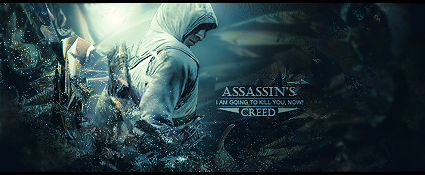
In general, working on a game will give an individual artist more creative input than that of a film production.
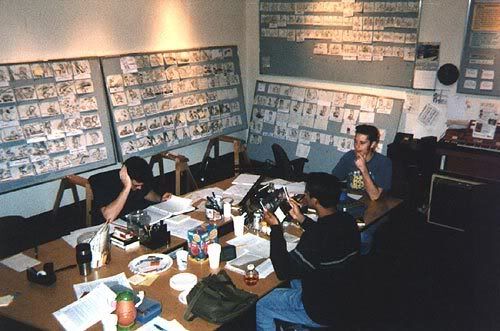
On the higher-profile film productions, individual artists usually have very little if any creative input.
In games, the opinions of even the most junior members of a team will usually be given as much consideration as the lead designers or company presidents.
On a film production, however, an animator’s great idea often gets lost in a hierarchical maze once it gets filtered through the sequence lead, the animation supervisor, the visual effects supervisor, the producers, the director, and the director’s on-set psychic advisor.
The last game company I worked for had a great saying:
“The idea doesn’t care where it came from”.
I rarely see such a philosophy in the film industry.
Who’s Leading the Charge?
When an artist works on a visual effects shot, he is basically leading the charge. It is a VISUAL effects shot after all. The technicians are generally there to support the art on such shots. Many times, it’s the character performance that is telling the story of the shot. Modelers, physiquers, programmers, cloth/hair/particle FX artists, lighters, compositors, rotoscopers more or less follow the lead of the animator.
In games, however, the art/animation always plays second fiddle to the design & programming. When a game artist has an aesthetic reason for wanting to make an asset larger, but the programmer has game-play and memory reasons for wanting it smaller, guess who wins? Many games contain some really outstanding visuals, but when you get right down to it, the art/animation in a video game is really just a glorified status report. It is pretty much there to tell you the condition of your character and whether or not you’re wining. Simply improving the art in a game rarely improves the game experience, unless doing so directly adds to the realism and immersive quality of the experience.
Is Tetris more fun when the blocks are 3-dimensional and cast shadows?
The visuals in games are indeed very important, but they always take a back seat to game-play.
Technical Restrictions
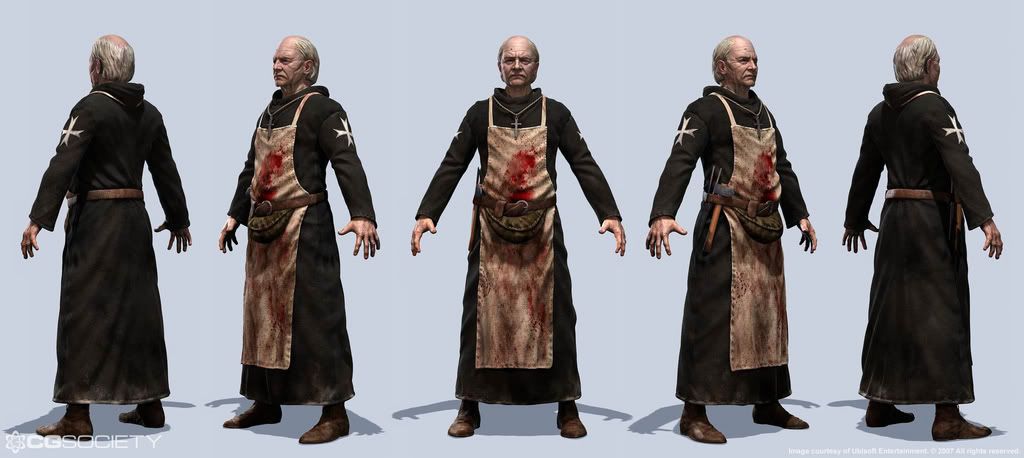 In games, the artist will work within a box of technical restrictions, including polygon count, number of joints, frame rate, texture resolution and memory. Film artists have less technical restrictions (but often more creative restrictions). These technical restrictions force game artists to tackle what we call constraint-based-design, which often demands a higher level of creative problem solving prowess.
In games, the artist will work within a box of technical restrictions, including polygon count, number of joints, frame rate, texture resolution and memory. Film artists have less technical restrictions (but often more creative restrictions). These technical restrictions force game artists to tackle what we call constraint-based-design, which often demands a higher level of creative problem solving prowess.Technical Knowledge
Game artists are generally expected to be technically savvy.
It’s easier to get away with being 100% right-brained in the films industry.
Innovation
The science of interactivity is still in its infancy. Knowing just what makes a game fun is still an evasive target. A good plot with well developed characters, solid acting, strong cinematography, intelligent directing, appropriate music, and decent FX will result in a good movie. The same rules do not apply in games. Make a strong plot and interesting characters for a video game, and junior will usually just ask you which buttons to press. A game must be easy enough to be fun yet difficult enough to be challenging. This is a fine line to walk and there are no formulas that can be implemented to arrive at a perfect balance between these two extremes. Game-play must be constantly tested and evaluated. Games offer more opportunities for experimentation. However, they also offer a lot of opportunities for failure. Films often fail as well, but it’s generally easier to figure out why.
Attention to Detail
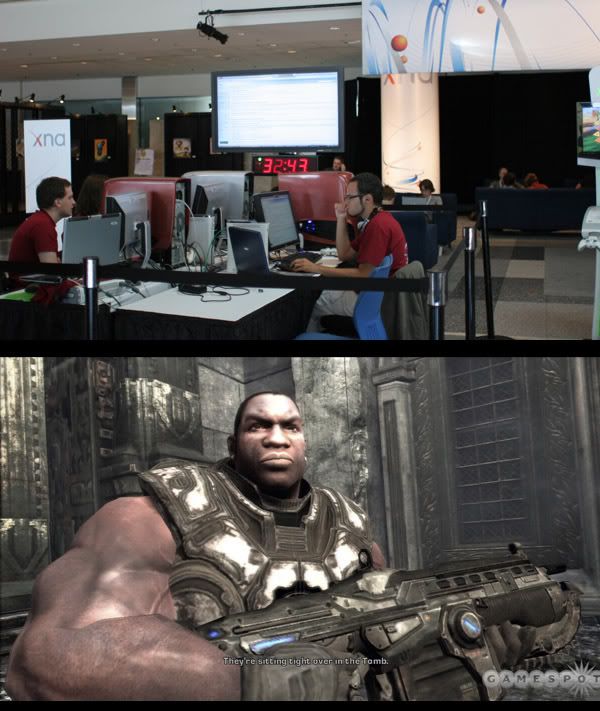 Film work tends to demand a higher level of attention to detail. However, a game artist will finish a production with a larger quantity of work.
Film work tends to demand a higher level of attention to detail. However, a game artist will finish a production with a larger quantity of work.An animator on a film production is usually given on average two weeks to complete a shot. A game animation is usually expected to be delivered in a matter of hours.
When working on a composite film shot (where a CG element is combined with a filmed background plate), a great deal of attention must be paid to matching the lighting and physics between the real and the invented elements. Games are rarely assembled this way, therefore, it’s usually more acceptable to bend the rules. However, internal consistency is an important element in both mediums.
Playing to Camera
In film, we have a saying:
“It doesn’t have to BE right, it just has to LOOK right.”
An animator can cheat a pose so that it looks perfect in the camera view, even though it might be totally off-balance if seen from a different POV. Most games are 3D these days, therefore the animations need to look good from every possible angle.
Global Fixes
A film animator’s favorite two words are “paint fix”. This means he doesn’t have to go in and fix that technical glitch. Rather, a 2D artist will touch up the final image later. No matter how many complex elements it takes to get there, the end result of a visual effects pipeline is a series of 2 dimensional images. There are many different opportunities along the pipeline to repair and improve a given shot. Furthermore, specific puppet setups and technical solutions can be applied to individual shots. A game, however, is an interactive experience. If you make a puppet change, it had better work for every animation in every scenario. And of course, there is no such thing as a “paint fix”.
Learning Potential
The film industry has been around a lot longer so there are more “seasoned” veterans around to learn from. However the potential to wear more hats in the games industry opens up a wider spectrum of potential instructors. Both industries can suffer from politics and ego problems.
Budgets
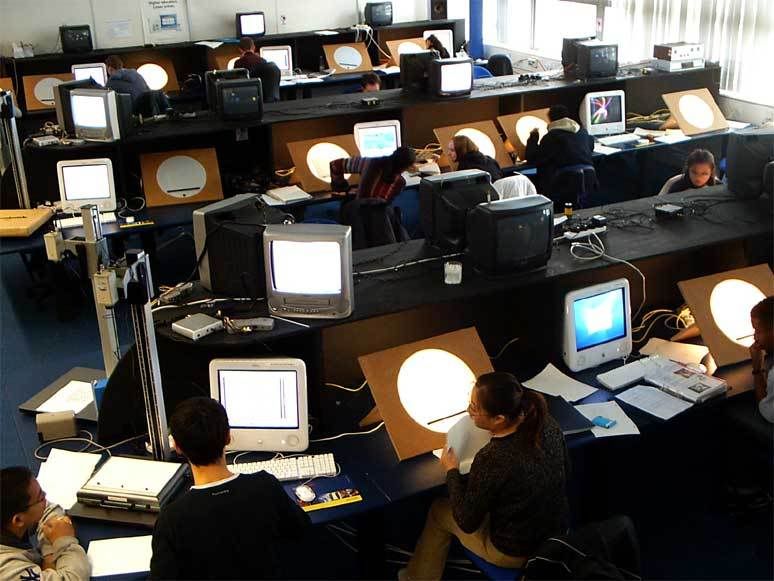 Film work tends to be more expensive than game work. The fact that more money is at stake is often the reason why there tends to be less opportunities for creativity and experimentation. However, the larger budgets in film productions often provide the artists with newer and better tools.
Film work tends to be more expensive than game work. The fact that more money is at stake is often the reason why there tends to be less opportunities for creativity and experimentation. However, the larger budgets in film productions often provide the artists with newer and better tools.Scheduling
Games are very difficult to schedule because they are new, innovative and the work is cumulative.
Scheduling a film FX production is usually much more straightforward. When a shot is done, it’s done.
Size
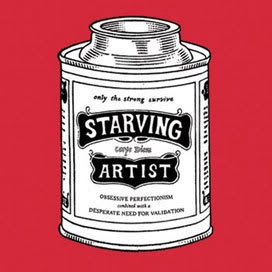 An average game production team is usually smaller than an average film FX team. This generally supports a more collaborative atmosphere.
An average game production team is usually smaller than an average film FX team. This generally supports a more collaborative atmosphere.Films tend to have a wider audience. Most of the general public will recognize your work. Being a game artist will make you a hero to your kids and their friends, but your Grandmother probably won’t think you have a real job.
Job Security
At present time, the games industry seems a bit more stable.
Most game artists are hired into staff positions where they expect to be employed at the same company long after the current production wraps. Many film artists, on the other hand, are “production hires”, where they expect to be looking for work during the final stages of their current project. Many film artists prefer the variety of bouncing around this way.
The Finish Line
A broken film can still be released, even if nothing works. The story elements can be weak, the acting can be horrible, the effects can be less than believable, the music can be inconsistent with the action, etc. It might get panned by the critics or go straight to video but it can still be released. If a game has even a single crash bug, however, it can’t be put on the shelf. It can be very frustrating for an artist to see his work sit and wait for months and months while the technical glitches are addressed. Of course, it can be equally painful for a film artist to pour his heart and soul and the highest level of his aesthetic skills into a production during a year of 14-hour days only to find his work attached to a poor story that gets reamed by the critics and falls out of the theaters after only a few days.
Bottom line
In games the journey is more satisfying, in film, it’s the destination. In games, you have more creative input, more variety in the work, generally less (and more flexible) hours, however, the end product is often very small, with limited detail, low poly-count, lower resolution texture mapping, and is often only seen by 14 year old boys. In film, you’re often pigeon-holed into a single discipline, you have very little if any creative input, the hours can be very long and structured. However, the end product is on a forty-foot screen, and a much wider section of the general public will recognize your work.
And thus ends a long, yet informative article. At least its good to be able to distinguish between the two types. And you know what would also be great after reading such a long and serious article? Eating Rap Snacks. From Japan. Nothing can be cooler.
 I especially like my chip bags that have great life lessons. It's like having the Ten Commandments on your Coke can or something. This stuff will make you rethink your life.
I especially like my chip bags that have great life lessons. It's like having the Ten Commandments on your Coke can or something. This stuff will make you rethink your life. And speaking of rethinking my life, I've got some... well, "sad" stuff to announce in my next post. I'm not so sure how many of you would actually care, but well, it matters to me, so I guess you should care. I mean, there are at least a dozen of you who go here, right? That means you care?
And speaking of rethinking my life, I've got some... well, "sad" stuff to announce in my next post. I'm not so sure how many of you would actually care, but well, it matters to me, so I guess you should care. I mean, there are at least a dozen of you who go here, right? That means you care?Shutting up now.






0 comments